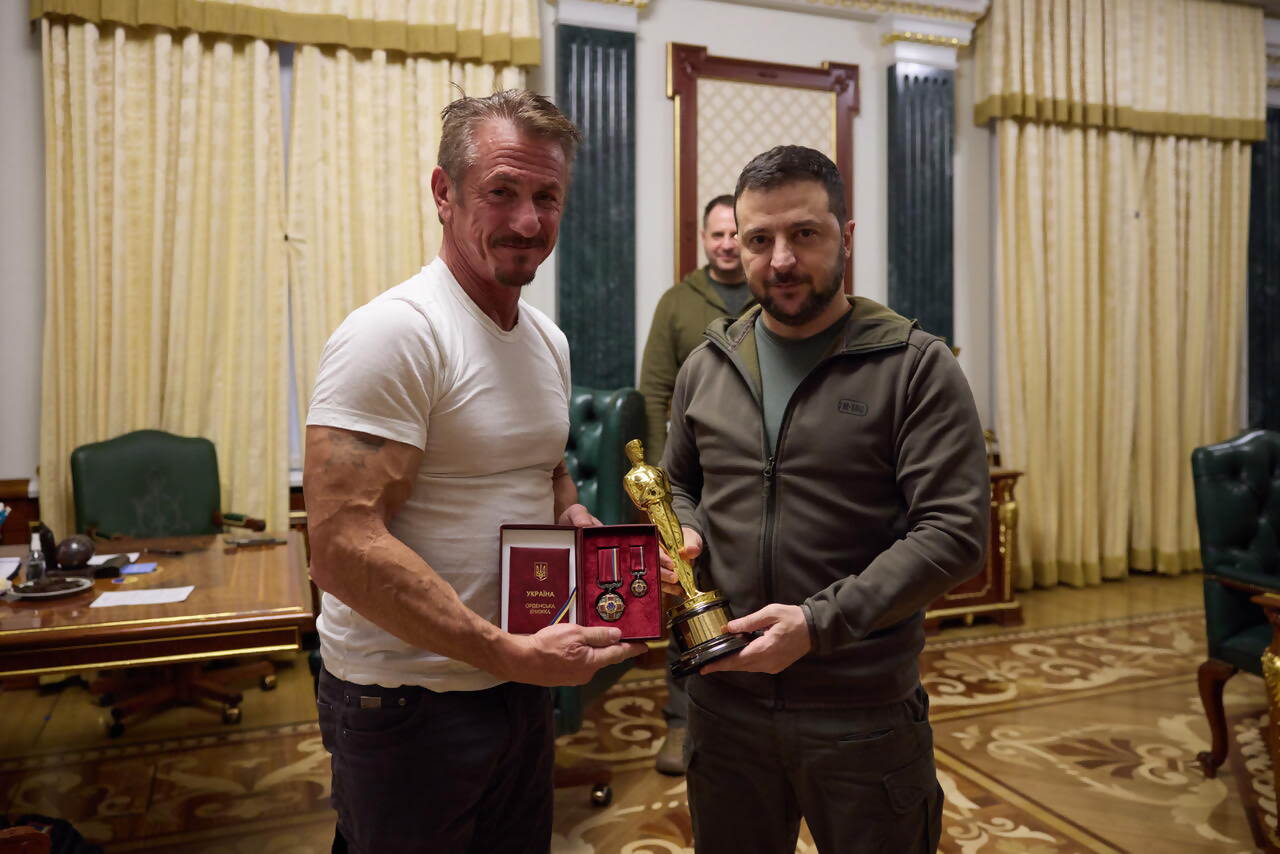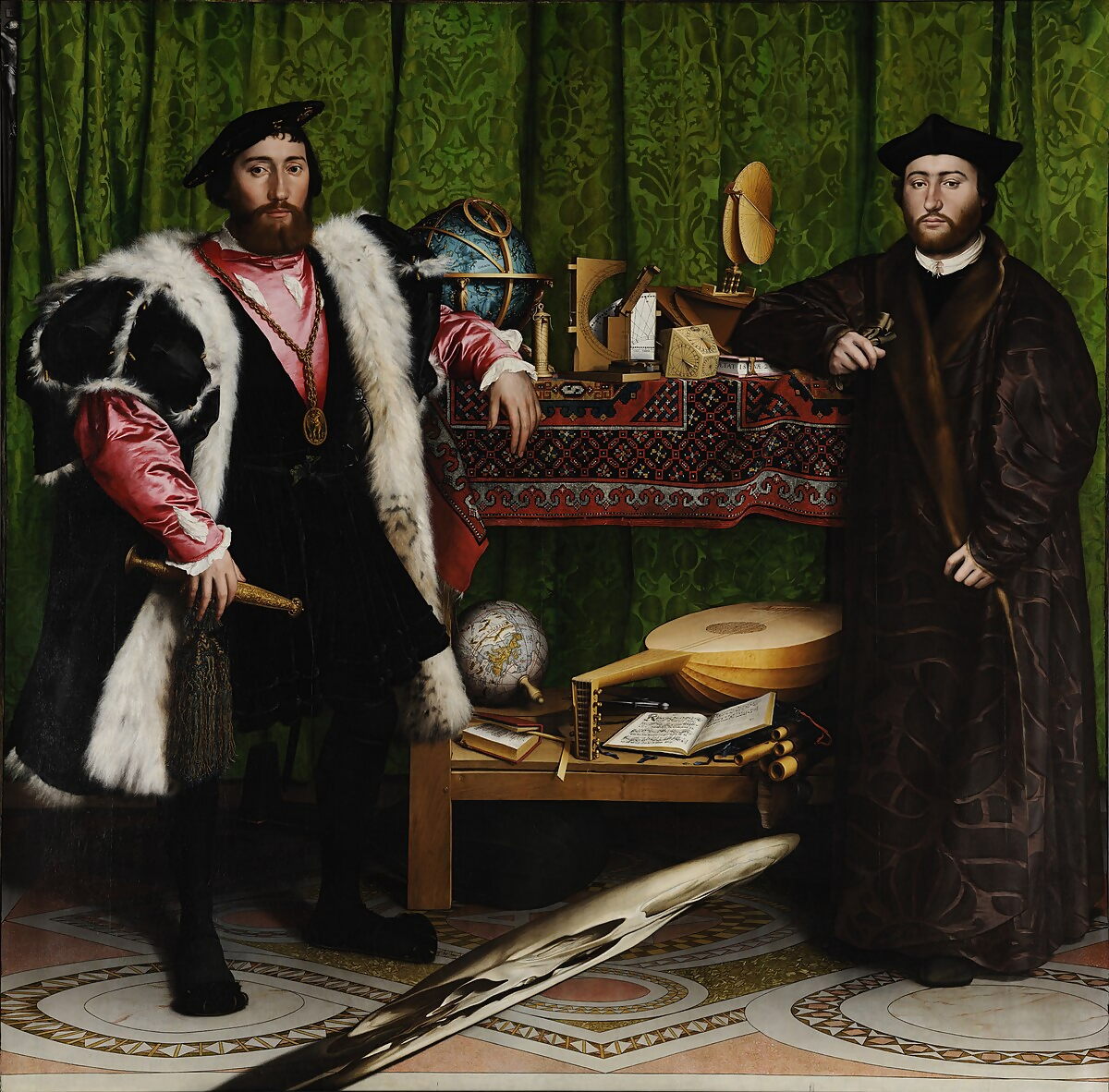
This week, Sean Penn handed his Oscar to Ukrainian President Volodymyr Zelensky as a ‘symbol of faith’. But in Deep Focus, we see the echoes of Hans Holbein the Younger’s 1533 painting, The Ambassadors.
(Photo credit: www.president.gov.ua)
Hans Holbein the Younger’s 1533 painting, The Ambassadors, is one of the most important images of the Tudor period. You probably know it: Jean de Dinteville, the French Ambassador to the court of Henry VIII, stands to the left of the painting, extravagantly puffed up in silk, velvet and lynx fur. To the right stands Georges de Selve, Bishop of Lavaur, more modestly swathed in brown clerical robes. Between the two figures, a table is laden with objects offering clues to the status of these men: scientific devices indicate learning and rationalism; globes, navigational instruments, and an Oriental rug signify travel and conquest; while a broken lute and a hymn book imply harmony between politics and the church.

The Ambassadors by Hans Holbein the Younger, 1533
But by far, the painting’s strangest and most impressive feature is the vast, anamorphic skull painted at the feet of the two men. Only visible from certain awkward angles, this prominent memento mori continues to puzzle art historians: what is it doing there? Why is it rendered like an optical illusion? And why – why – is it so huge?
A recent photograph of the actor Sean Penn and the Ukrainian President Volodymyr Zelensky doesn’t have a massive anamorphic skull in the foreground – but it does put one in mind of ‘The Ambassadors’. In this Ukrainian stateroom, heavy drapes, a gilt wood table, and a swirly floor pattern all echo the ambassadorial setting of Holbein’s painting, while the two men adopt the poses of de Dinteville and de Selve like modern-day mirror images.
Penn has swapped the puff of rich fabric for the swell of inflated muscles, but the effect remains the same: like de Dinteville almost half a millennium before him, Penn knows that he’s the celebrity here. Zelensky, on the other hand – decked out in muted, military khaki – has assumed something of a saintly air since Russia invaded Ukraine – if not by design, then in the eyes of great swathes of the press in the West (and presumably also in Penn’s eyes). And though Penn is no national representative, he assumes something of the role of Hollywood’s ambassador here. In his visit to Zelenskyy, Penn represents those other high-profile Americans who, like himself, have been banned from entering Russia because of their vocal denunciation of the invasion of Ukraine (the list includes Hillary Clinton, Ben Stiller and Morgan Freeman).
SEE MORE: The relentless innovation of Hiro
But what about the objects in this photo? What do they tell us about US-Ukraine relations? Like Holbein’s delicate balance of the religious and the secular, the two central items in the Penn-Zelensky image reveal a sense of solidarity, not between church and state but between cinema and state. Penn has bestowed upon Zelensky Hollywood’s highest honour: the golden Oscar statuette. In return, Zelensky hands over Ukraine’s Order of Merit, ordinarily given to individuals for outstanding achievements in economics, science, culture, military or political spheres of activity. (Penn, incidentally, gets to keep his hard-earned medal for life, but the Oscar is only on loan: Zelensky will have to give it back ‘when [he] wins’, Penn says).
But not so fast. Because one school of art history says that the appearance of the lute with its broken string in Holbein’s painting hints, not at harmony, but at the discord between church and state (the year ‘The Ambassadors’ was painted was also the year in which Henry VIII broke with the Catholic church). Looking back at the Penn-Zelensky photo, do I detect the hint of a grimace on the Oscar statuette? If you view it from a certain angle…what’s that? The patterns on the floor create a giant, distorted skull!
Ok, so the apparition of the skull is wishful thinking – but perhaps Penn could learn from the memento mori, which Roman slaves first whispered into the ears of victorious generals to warn against excessive hubris. Kudos on getting blacklisted by Russia, Sean, but whichever way you look at it, the very public lease of the Oscar was a self-important move (*whispers* memento mori).


